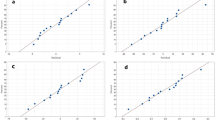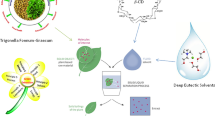Abstract
This paper aimed to optimize the extraction of antioxidants from plum seeds (Prunus domestica L.) using ultrasound-assisted extraction. The Box–Behnken design was used for the optimization of the extraction process. The four extraction parameters, such as the extraction time (10–40 min), ethanol concentration (20–100%, v/v), liquid-to-solid ratio (10–30 cm3 g−1), and extraction temperature (30–70 °C) were varied to investigate their impact on the content of antioxidants. Using HPLC methods, the following phenolic compounds were identified and quantified per 100 g dry weight: rutin (6.39 mg), epigallocatechin (1.94 mg), gallic acid (0.64 mg), ferulic acid (14.30 mg), syringic acid (0.87 mg), epicatechin (0.95 mg), caffeic acid (0.30 mg), and coumaric acid (11.18 mg). The content of amygdalin was 1.5 mg g−1 of the dry extract obtained under optimal conditions. Antioxidant activity was determined using the DPPH assay and estimated based on the half-maximal inhibitory concentration (IC50). The IC50 value of the extract obtained under optimal conditions was 0.94 mg cm−3. The proposed green technique is an economical and alternative procedure for the extraction of antioxidants by application of non-toxic and eco-friendly solvents. From the ecological point of view, it is acceptable due to the reduction of waste either after plum cultivation or production of alcoholic beverages.


Similar content being viewed by others
Abbreviations
- UAE:
-
Ultrasound-assisted extraction
- FCR:
-
Folin–Ciocalteu reagent assay
- d.w.:
-
Dry weight
- DPPH:
-
2,2-Diphenyl-1-picrylhydrazyl
- GAE:
-
Gallic acid equivalent
- IC50 :
-
Half-maximal inhibitory concentration
- BHT:
-
Butylhydroxytoluene
References
Blaheta RA, Nelson K, Haferkamp A, Juengel E (2016) Amygdalin, quackery or cure? Phytomedicine 23(4):367–376
Bolarinwa IF, Orfila C, Morgan MR (2014) Amygdalin content of seeds, kernels and food products commercially-available in the UK. Food Chem 152:133–139
Chemat F, Rombaut N, Sicaire AG, Meullemiestre A, Fabiano-Tixier AS, Abert-Vian M (2017) Ultrasound assisted extraction of food and natural products. Mechanisms, techniques, combinations, protocols and applications. A review. Ultrason Sonochem 34:540–560
Chen S, Zeng Z, Hu N, Bai B, Wang H, Suo Y (2018) Simultaneous optimization of the ultrasound-assisted extraction for phenolic compounds content and antioxidant activity of Lycium ruthenicum Murr. fruit using response surface methodology. Food Chem 242:1–8
Chun OK, Kim DO (2004) Consideration on equivalent chemicals in total phenolic assay of chlorogenic acid-rich plums. Food Res Int 37(4):337–342
Cory H, Passarelli S, Szeto J, Tamez M, Mattei J (2018) The role of polyphenols in human health and food systems: a mini-review. Fronti Nutr 5:87
d’Alessandro LG, Kriaa K, Nikov I, Dimitrov K (2012) Ultrasound assisted extraction of polyphenols from black chokeberry. Sep Purif Technol 93:42–47
Dulf FV, Vodnar DC, Socaciu C (2016) Effects of solid-state fermentation with two filamentous fungi on the total phenolic contents, flavonoids, antioxidant activities and lipid fractions of plum fruit (Prunus domestica L.) by-products. Food Chem 209:27–36
Espada-Bellido E, Ferreiro-González M, Carrera C, Palma M, Barroso CG, Barbero GF (2017) Optimization of the ultrasound-assisted extraction of anthocyanins and total phenolic compounds in mulberry (Morus nigra) pulp. Food Chem 219:23–32
Ferreira SL, Bruns RE, Ferreira HS, Matos GD, David JM, Brandão GC, da Silva EG, Portugal LA, dos Reis PS, Souza AS, dos Santos WN (2007) Box–Behnken design: an alternative for the optimization of analytical methods. Anal Chim Acta 597:179–186
Fu S, Zhang J, Li T, Wang S, Ding W, Zhao M, Du Y, Wang Q, Jia J (2014) Multi-responses extraction optimization based on response surface methodology combined with polarity switching HPLC–MS/MS for the simultaneous quantitation of 11 compounds in Cortex Fraxini: application to four species of Cortex Fraxini and its 3 confusable species. J Pharm Biomed Anal 91:210–221
González-Garcia E, Marina ML, García MC (2014) Plum (Prunus domestica L.) by-product as a new and cheap source of bioactive peptides: extraction method and peptides characterization. J Funct Foods 11:428–437
González-García E, García MC, Marina ML (2018) Capillary liquid chromatography-ion trap-mass spectrometry methodology for the simultaneous quantification of four angiotensin-converting enzyme-inhibitory peptides in Prunus seed hydrolysates. J Chromatogr A 1540:47–54
Górnaś P, Mišina I, Grāvīte I, Lācis G, Radenkovs V, Olšteine A, Segliņa D, Kaufmane E, Rubauskis E (2015a) Composition of tocochromanols in the kernels recovered from plum pits: the impact of the varieties and species on the potential utility value for industrial application. Eur Food Res Technol 241(4):513–520
Górnaś P, Mišina I, Olšteine A, Krasnova I, Pugajeva I, Lācis G, Siger A, Michalak M, Soliven A, Segliņa D (2015b) Phenolic compounds in different fruit parts of crab apple: dihydrochalcones as promising quality markers of industrial apple pomace by-products. Ind Crops Prod 74:607–612
Górnaś P, Dwiecki K, Siger A, Tomaszewska-Gras J, Michalak M, Polewski K (2016a) Contribution of phenolic acids isolated from green and roasted boiled-type coffee brews to total coffee antioxidant capacity. Eur Food Res Technol 242(5):641–653
Górnaś P, Rudzinska M, Raczyk M, Misina I, Soliven A, La̅cis G, Seglina D (2016b) Impact of species and variety on concentrations of minor lipophilic bioactive compounds in oils recovered from plum kernels. J Agric Food Chem 64(4):898–905
Górnaś P, Rudzińska M, Soliven A (2017) Industrial by-products of plum Prunus domestica L. and Prunus cerasifera Ehrh. as potential biodiesel feedstock: impact of variety. Ind Crop Prod 100:77–84
Haddadi-Guemghar H, Janel N, Dairou J, Remini H, Madani K (2014) Optimisation of microwave-assisted extraction of prune (Prunus domestica) antioxidants by response surface methodology. Int J Food Sci Technol 49(10):2158–2166
He B, Zhang LL, Yue XY, Liang J, Jiang J, Gao XL, Yue PX (2016) Optimization of ultrasound-assisted extraction of phenolic compounds and anthocyanins from blueberry (Vaccinium ashei) wine pomace. Food Chem 204:70–76
Huang D, Ou B, Prior RL (2005) The chemistry behind antioxidant capacity assays. J Agric Food Chem 53:1841–1856
Igwe EO, Charlton KE (2016) A systematic review on the health effects of plums (Prunus domestica and Prunus salicina). Phytother Res 30(5):701–731
Jaiswal R, Karaköse H, Rühmann S, Goldner K, Neumüller M, Treutter D, Kuhnert N (2013) Identification of phenolic compounds in plum fruits (Prunus salicina L. and Prunus domestica L.) by high-performance liquid chromatography/tandem mass spectrometry and characterization of varieties by quantitative phenolic fingerprints. J Agric Food Chem 61(49):12020–12031
Khallouki F, Haubner R, Erben G, Ulrich CM, Owen RW (2012) Phytochemical composition and antioxidant capacity of various botanical parts of the fruits of Prunus × domestica L. from the Lorraine region of Europe. Food Chem 133(3):697–706
Kijima H, Ide T, Otsuka H, Ogimi C, Hirata E, Takushi A, Takeda Y (1997) Water-soluble phenolic glycosides from leaves of Alangium premnifolium. Phytochemistry 44(8):1551–1557
Kim YC, Koh KS, Koh JS (2001) Changes of flavonoids in the peel of Jeju native citrus fruits during maturation. Food Sci Biotechnol 10(5):16–20
Liu Y, Wei S, Liao M (2013) Optimization of ultrasonic extraction of phenolic compounds from Euryale ferox seed shells using response surface methodology. Ind Crop Prod 49:837–843
Liu L, Shen BJ, Xie DH, Cai BC, Qin KM, Cai H (2015) Optimization of ultrasound-assisted extraction of phenolic compounds from Cimicifugae rhizoma with response surface methodology. Pharmacogn Mag 11(44):682
Łoś J, Wilska-Jeszka J, Pawlak M (2000) Polyphenolic compounds of plums (Prunus domestica). Pol J Food Nutr Sci 9(1):35–38
Luo X, Cui J, Zhang H, Duan Y, Zhang D, Cai M, Chen G (2018) Ultrasound assisted extraction of polyphenolic compounds from red sorghum (Sorghum bicolor L.) bran and their biological activities and polyphenolic compositions. Ind Crops Prod 112:296–304
Ma YQ, Chen JC, Liu DH, Ye XQ (2009) Simultaneous extraction of phenolic compounds of citrus peel extracts: Effect of ultrasound. Ultrason Sonochem 16(1):57–62
Makarova E, Górnaś P, Konrade I, Tirzite D, Cirule H, Gulbe A, Pugajeva I, Seglinac D, Dambrova M (2015) Acute anti-hyperglycaemic effects of an unripe apple preparation containing phlorizin in healthy volunteers: a preliminary study. J Sci Food Agric 95(3):560–568
Matthaeus B, Oezcan MM (2009) Fatty acids and tocopherol contents of some Prunus spp. kernel oils. J Food Lipids 16(2):187–199
Milala J, Kosmala M, Sójka M, Kołodziejczyk K, Zbrzeźniak M, Markowski J (2013) Plum pomaces as a potential source of dietary fibre: composition and antioxidant properties. J Food Sci Technol 50(5):1012–1017
Miletic N, Popovic B, Mitrovic O, Kandic M (2012) Phenolic content and antioxidant capacity of fruits of plum Stanley (Prunus domestica L.) as influenced by maturity stage and on-tree ripening. Aust J Crop Sci 6(4):681–687
Mocan A, Diuzheva A, Carradori S, Andruch V, Massafra C, Moldovan C, Sisead C, Petzere JP, Petzere A, Zarac S, Diletta Marconic G, Zenginf G, Crișana G, Marconi GD (2018) Development of novel techniques to extract phenolic compounds from Romanian cultivars of Prunus domestica L. and their biological properties. Food Chem Toxicol 119:189–198
Nour V, Trandafir I, Cosmulescu S (2013) HPLC determination of phenolic acids, flavonoids and juglone in walnut leaves. J Chromatogr Sci 51(9):883–890
Poti F, Santi D, Spaggiari G, Zimetti F, Zanotti I (2019) Polyphenol health effects on cardiovascular and neurodegenerative disorders: a review and meta-analysis. Int J Mol Sci 20(2):351
Richter BE, Jones BA, Ezzell JL, Porter NL, Avdalovic N, Pohl C (1996) Accelerated solvent extraction: a technique for sample preparation. Anal Chem 68(6):1033–1039
Riciputi Y, Diaz-de-Cerio E, Akyol H, Capanoglu E, Cerretani L, Caboni MF, Verardo V (2018) Establishment of ultrasound-assisted extraction of phenolic compounds from industrial potato by-products using response surface methodology. Food Chem 269:258–263
Santos-Marques J, Georgakis C, Mustakis J, Hawkins JM (2019) From dynamic response surface models to the identification of the reaction stoichiometry in a complex pharmaceutical case study. AIChE J 65(4):1173–1185
Savic IM, Nikolic VD, Savic-Gajic IM, Nikolic LB, Ibric SR, Gajic DG (2015) Optimization of technological procedure for amygdalin isolation from plum seeds (Pruni domesticae semen). Front Plant Sci 6:276
Savic IM, Nikolic VD, Savic-Gajic IM, Kundakovic TD, Stanojkovic TP, Najman SJ (2016) Chemical composition and biological activity of the plum seed extract. Adv Technol 5(2):38–45
Savic-Gajic IM, Savic IM, Nikolic VD (2018) Modelling and optimization of quercetin extraction and biological activity of quercetin-rich red onion skin extract from Southeastern Serbia. J Food Nutr Res 57(1):15–26
Savic-Gajic I, Savic I, Boskov I, Žerajić S, Markovic I, Gajic D (2019) Optimization of ultrasound-assisted extraction of phenolic compounds from black locust (Robiniae pseudoacaciae) flowers and comparison with conventional methods. Antioxidants 8(8):248
Sójka M, Kołodziejczyk K, Milala J, Abadias M, Viñas I, Guyot S, Baron A (2015) Composition and properties of the polyphenolic extracts obtained from industrial plum pomaces. J Funct Foods 12:168–178
Topp BL, Russell DM, Neumüller M, Dalbó MA, Liu W (2012) Plum. In: Badenens ML, Byrne DH (eds) Fruit breeding. Springer, New York, pp 571–621
Turturica M, Stanciuc N, Bahrim G, Rapenau G (2016) Effect of thermal treatment on phenolic compounds from plum (Prunus domestica) extracts—a kinetic study. J Food Eng 171:200–207
Vangdal E, Slimestad R (2006) Methods to determine antioxidative capacity in fruit. J Fruit Ornam Plant Res 14:123–131
Wang J, Sun B, Cao Y, Tian Y, Li X (2008) Optimisation of ultrasound-assisted extraction of phenolic compounds from wheat bran. Food Chem 106(2):804–810
Xu DP, Zheng J, Zhou Y, Li Y, Li S, Li HB (2017) Ultrasound-assisted extraction of natural antioxidants from the flower of Limonium sinuatum: optimization and comparison with conventional methods. Food Chem 217:552–559
Xue F, Zhu C, Liu F, Wang S, Liu H, Li C (2018) Effects of high-intensity ultrasound treatment on functional properties of plum (Pruni domesticae semen) seed protein isolate. J Sci Food Agr 98(15):5690–5699
Acknowledgements
This work was supported by the Republic of Serbia—Ministry of Education, Science and Technological Development under Program for financing scientific research work, No. 451-03-68/2020-14/200133.
Author information
Authors and Affiliations
Corresponding author
Additional information
Publisher's Note
Springer Nature remains neutral with regard to jurisdictional claims in published maps and institutional affiliations.
Rights and permissions
About this article
Cite this article
Savic, I.M., Savic Gajic, I.M. Optimization study on extraction of antioxidants from plum seeds (Prunus domestica L.). Optim Eng 22, 141–158 (2021). https://doi.org/10.1007/s11081-020-09565-0
Received:
Revised:
Accepted:
Published:
Issue Date:
DOI: https://doi.org/10.1007/s11081-020-09565-0




